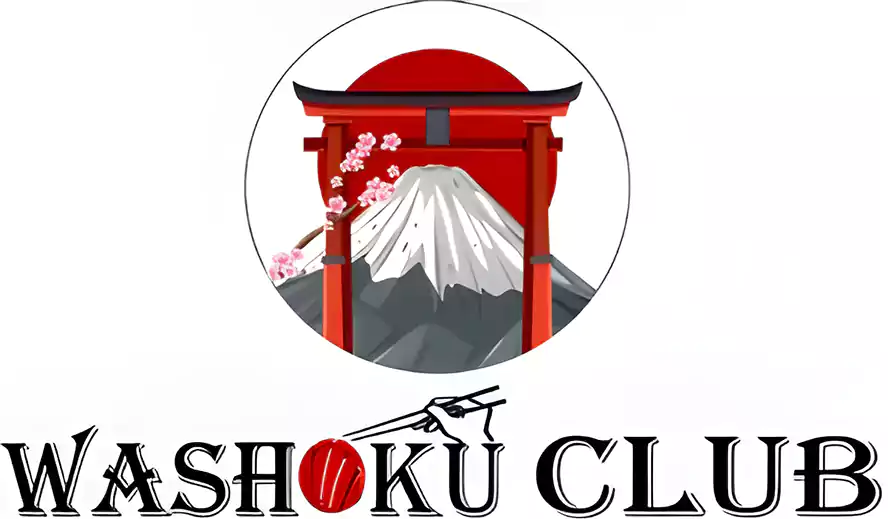Discover Kyoto Best Flavors: Your Ultimate Guide To An Unforgettable Kyoto Food Tour
Kyoto is one of those cities that can leave you feeling like you’ve stepped into a different world. It’s one of those cities where every corner has a tale, and the tale is told through its food. Imagine walking through bustling markets, sampling the delicate nuances of a beautifully prepared Kaiseki meal, or sipping matcha in a hidden, secluded teahouse. In Kyoto, food is not merely something one consumes—it’s an experience, a means of connecting with the city’s rich culture and history. Eating on the Kyoto Food Tour is not merely tasting various foods; it’s learning the soul of Kyoto, bite by bite, and feeling connected to the traditions that have sculpted this lovely city.
Is It Worth Doing A Food Tour In Kyoto?
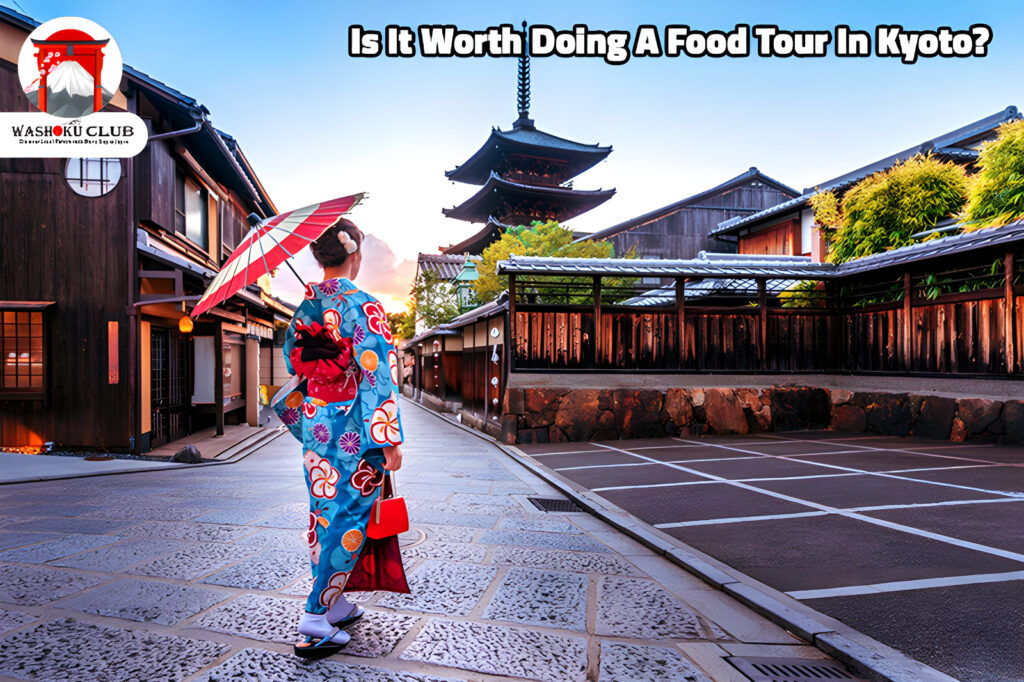
If you’re curious as to whether a Kyoto Food Tour is worth your time, the answer is an emphatic, absolutely yes! A Kyodo meal is less about what you have and more about tapping into the essence of the city. A food tour here gets you off the tourist trail, where you experience the hidden gems and local haunts that define Kyoto’s gastronomic landscape.
From beautifully crafted seasonal cuisine to fabled sweets like matcha-flavored sweets, every bite you take has a story behind it. And what better way to indulge in Kyoto’s enchantment than to embark on a mission with a passionate local guide who will take you through the culinary history of the city? Trust us, a Kyoto Food Tour will make your trip unforgettable, allowing you to discover the city like a local and enjoy flavors that are nowhere else to be found.
What Is a Famous Food In Kyoto
Kyoto’s cuisine is a beautiful mix of tradition, simplicity, and refined flavors. Here’s a guide to the must-try dishes you’ll discover on a Kyoto Food Tour :
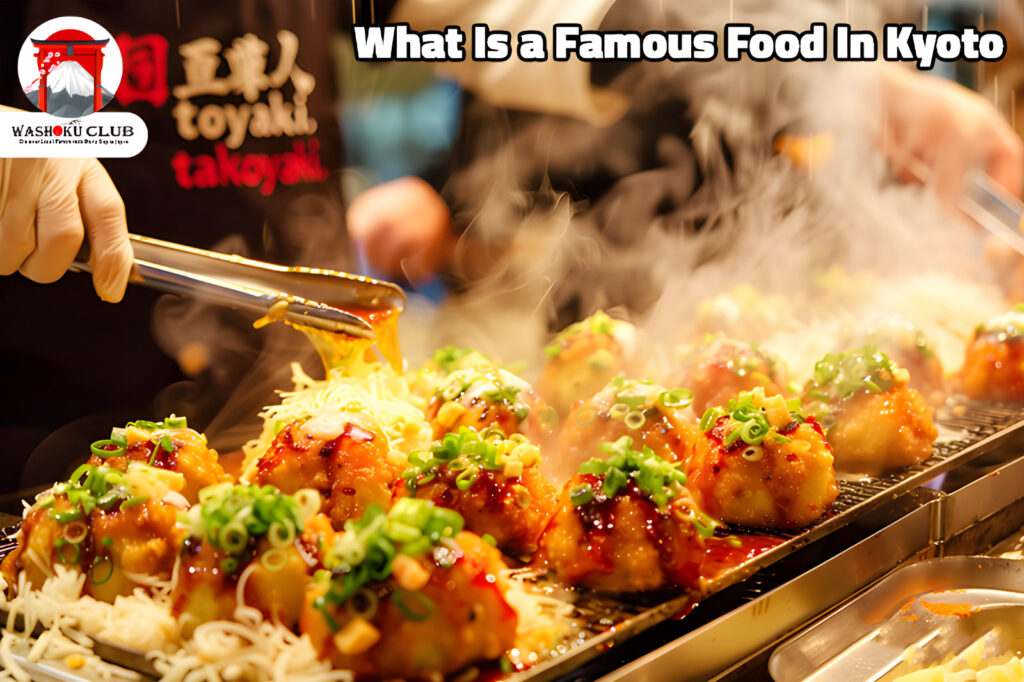
Shojin Ryori (Buddhist Vegetarian Cuisine)
Shojin Ryori is not just vegetarian food; it’s an expression of Kyoto’s deep spiritual culture. Developed in Buddhist monasteries, this cuisine follows the philosophy of non-violence (ahimsa), i.e., no animal products are used. Expect a daintily balanced meal of fresh seasonal vegetables, tofu, yuba (tofu skin), konnyaku (yam cake), seaweed, and wild mountain greens. Each dish is prepared separately to permit natural flavors instead of overseasoning, resulting in a perfect balance of taste, texture, and color. A typical Shojin Ryori meal is composed of small pieces of boiled, grilled, and pickled vegetables, a little miso soup, and rice. making it a common feature on any Kyoto Food Tour.
Yudofu and Yuba (Tofu Hot Pot and Tofu Skin)
Yudofu and yuba are Kyoto classics that illustrate the city’s mastery of simplicity and purity of food. Yudofu is a comforting yet simple dish where soft blocks of tofu are lightly simmered in a light kombu (kelp) broth. Something you’ll often encounter on a Kyoto Food Tour through local restaurants. It’s usually served with dipping sauces like soy sauce, ponzu, or grated ginger so that the clean, delicate flavor of tofu can shine.
Yuba, as opposed to Yudofu, is the delicate, silky skin that forms on top of hot soy milk. It’s often eaten fresh with a dash of soy sauce or utilized as a garnish for soups and sashimi-style dishes. Both Yudofu and Yuba are reflective of Kyoto’s refined vegetarian tradition and are must-tries for any seeker of authentic, upscale Japanese flavors.
Nishin Soba (Herring Soba Noodles)
Nishin Soba is one of Kyoto’s popular noodle dishes that combines rich buckwheat soba with the rich, sweet flavor of herring cooked in sweet-savory soy, sugar, and mirin sauce. On a Kyoto Food Tour, this dish often surprises visitors with its perfect balance of sweet and savory notes.
The nishin, which is a fillet of cooked herring, is the highlight of the dish and is cooked until tender and well flavored in the sweet-savory soy, sugar, and mirin sauce. Served in a steaming bowl of soba noodles over a flavorful dashi broth, the overall effect is one of absolute harmony of flavor and texture—chewy noodles, umami-laden broth, and fish that just dissolves in your mouth. Nishin Soba is especially showcased during New Year’s, but it’s a rich dish to try at any time of the year when in Kyoto.
Kyozushi (Kyoto-style Sushi)
Kyozushi offers a unique form of sushi that reflects Kyoto’s interior history and centuries-long preservation technique. In contrast to coastal municipalities utilizing fresh raw fish, Kyoto sushi employs preservable components like mackerel (sabazushi), pickled vegetables, and vinegared rice. Sabazushi, the city specialty, consists of vinegared mackerel rolled over scented rice and often topped with kelp or bamboo leaves to enhance flavor. You will also discover lightly made oshizushi (pressed sushi) and inari sushi (tofu pouches of rice stuffed inside), each executed with Kyoto-style finesse. It’s no surprise that many Kyoto Food Tour itineraries highlight Kyozushi, as each bite brings together the combination of sweet, sour, and umami, making it a top-choice experience for visitors.
Obanzai (Kyoto-style Home Cooking)
Obanzai is the embodiment of Kyoto home cooking—a style that’s simple, seasonal, and genuinely comforting. Rooted in mottainai philosophy (not wasting a thing), Obanzai is an intelligent composition of easily found, usually plain ingredients like tofu, whatever vegetables are in season, seaweed, and pickles. Basic foods can be steamed eggplant, sweet root vegetables glazed in miso, or kinpira (burdock and carrot stir-fried).
On a Kyoto Food Tour, you’ll experience the true heart of this culinary tradition, where the focus isn’t on fancy presentation but the affection and care poured into each meal. When you have Obanzai, you are not just eating—you’re tasting centuries of Kyoto tradition passed down from home kitchen to home kitchen. It is cozy, comforting, and imperative for anyone willing to get Kyoto’s authentic culinary soul.
Kaiseki (Traditional Multi-course Meal)
Kaiseki is Kyoto’s gem of cuisine, a refined, artistic multi-course dish that respects seasonality, balance, and beauty. Drawn on the traditions of the Japanese tea ceremony, Kaiseki is not just an exercise in taste but an invitation for all five senses to participate.
A typical Kaiseki experience is a story: delicate appetizers, clear soup, sashimi, grilled fare, simmered vegetables, and a refined finish of rice, pickles, and a light dessert. Every dish is presented like a painting, made with fresh seasonal ingredients arranged with care to create a sense of color and balance. For anyone joining a Kyoto Food Tour, dining on Kaiseki is more than a meal—it’s a journey through Japanese aesthetics and hospitality, and one that will remain a memorable centerpiece of their experience.
Uji Matcha (Premium Green Tea from Uji)
Uji Matcha is one of Kyoto’s best-loved gems, prized for its richness of flavor and deep cultural heritage. Sourced from the beautiful town of Uji near Kyoto, this well-milled green tea is famous for its bright green color, rich texture, and umami-rich flavor.
Whether savored at a proper tea ceremony or enjoyed as dessert like matcha ice cream, cakes, or parfaits, Uji Matcha is a treat to the senses.
Its flavor is perfectly balanced between the natural sweetness and slight bitterness, and that makes it loved by locals as well as overseas tourists. Any Kyoto Food Tour is not complete without a taste of Uji Matcha—it is the true flavor of the refinement and thousand-year tea culture of Kyoto.
Best Kyoto Food Tours To Savor Authentic Flavors: Your Guide to the Best Places in Kyoto
Kyoto is not all about incredible food—although that’s a big part of it—it’s a city where every garden, temple, and street makes you wish to slow down and take in centuries of beauty. While on your Kyoto Food Tour adventure, make sure to stop by these timeless spots that define Kyoto’s ageless charm:
Gion District: A Taste of Kyoto’s Historic Heart
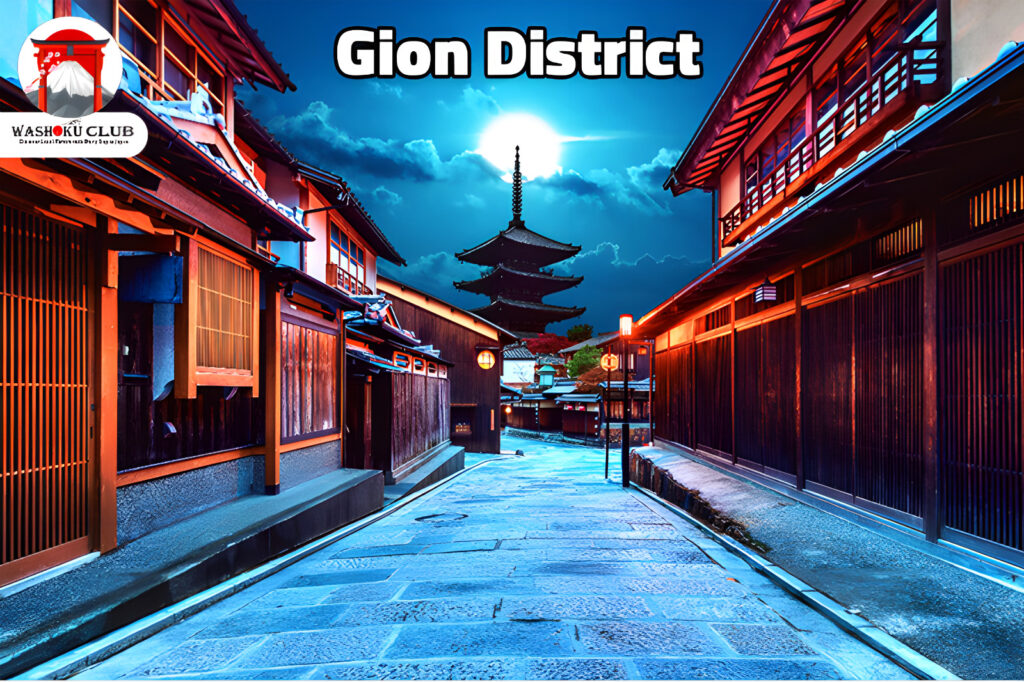
Gion is Kyoto’s most romantic and celebrated district, where myth is inhaled with each wooden column and stone sidewalk. Along its streets, you’ll find quaintly maintained machiya townhouses, softly glowing lanterns, and the occasional glimpse of a maiko (apprentice geisha) beautifully rushing to an evening appointment.
By day, Gion has charming teahouses, old-fashioned craft shops, and ancient shrines to explore. But after dark, the district is something truly special—the gentle sounds of shamisen music waft through the air, and the streets are lined with paper lanterns, creating an atmosphere that is simply not to be missed.
If you book a Kyoto Food Tour, you’re in for a treat: look forward to dainty Kyoto-style sushi, meaty yakitori skewers, and matcha sweets. With an insider guide, you will not only taste the top of Kyoto but also hear all about this historic district.
Wander through the magical Gion district, home of geisha culture, while tasting regional specialties handpicked just for you with our Food Tour (Personalized Gion Half-Day Food Tour with Local Expert) This personalized tour lets you dive into Kyoto’s culinary scene at your own pace, with insider tips and fascinating cultural insights along the way.
Fushimi Inari Taisha: A Spiritual Journey Through the Red Gates
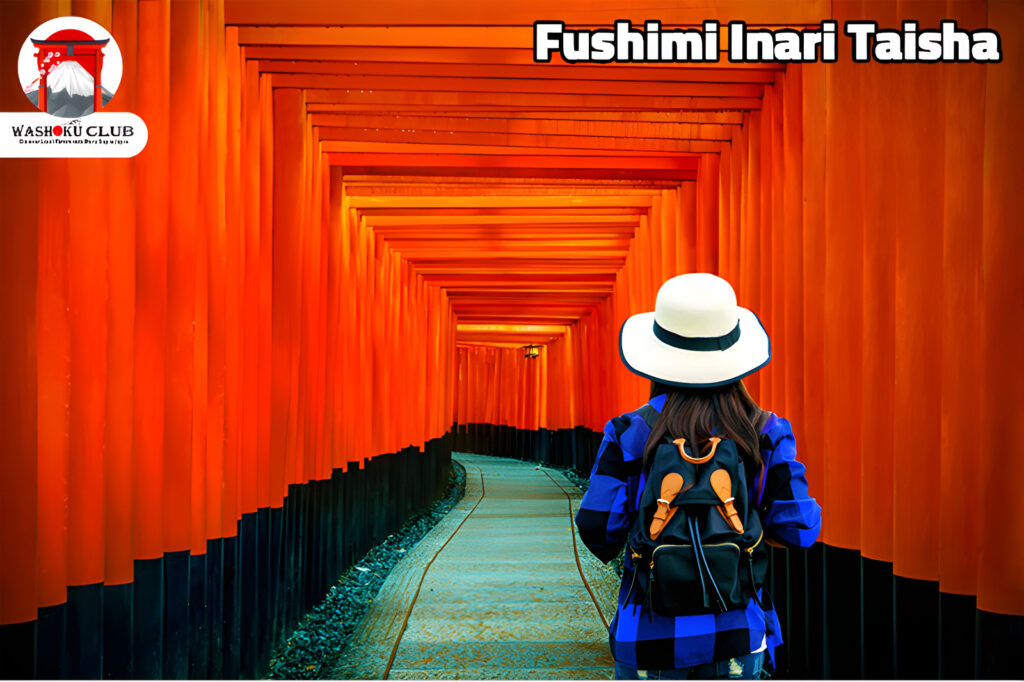
Fushimi Inari Taisha is not just a shrine but one of Kyoto’s most moving and fascinating experiences. Famous for its hundreds of bright red torii gates, this religious complex winds its way up Mount Inari, creating undulating paths that are akin to nothing so much as stepping into another world.
As you walk through these mythical gates, you’ll see tiny shrines, stone fox statues (messengers of Inari), and peaceful forest walks. Whether you arrive in the morning when sunlight pours gently through the gates or in the evening when the forest burns golden, Fushimi Inari is magic.
For the foodies, the shrine’s surrounding area is also a secret gem! There are stalls offering tasty local street food, such as inari sushi (rice wrapped in tofu), yakitori, and even taiyaki fish-shaped cakes fresh from the griddle. A visit to Fushimi Inari is the ideal combination of culture, nature, and food exploration that will take any Kyoto Food Tour experience to the next level.
And if you want to dive deeper into the city, then the Kyoto Hidden Gems to Discover by a Local Guide tour is the ticket. It takes you beyond the guidebook neighborhoods and lets you discover secret little spots close to Fushimi Inari, not-so-famous local cafes, and the amazing views that you would probably miss on your own. With your own dedicated local guide, you will truly feel the real pulse of Kyoto.
Kinkaku-ji (Golden Pavilion): A Shimmering Icon of Kyoto
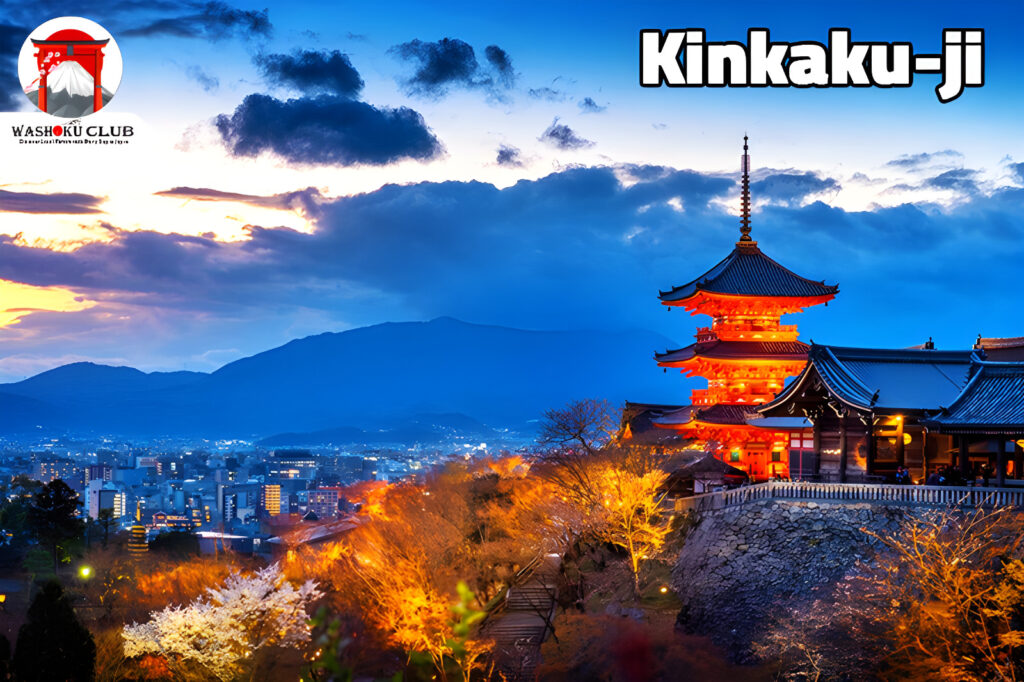
The Golden Pavilion, or Kinkaku-ji, is certainly the most breathtaking and recognizable of Kyoto’s symbols. Surrounded by sheets of shimmering gold leaf, this Zen Buddhist temple sits graciously alongside a peaceful, mirror-still pond, offering up a scene so lovely that it appears virtually unreal. Whether set amidst flowering cherry blossoms in springtime, lush leaves in summer, fiery red maples in autumn, or a delicate blanket of snow in winter, Kinkaku-ji is a masterpiece of beauty and equilibrium.
As you wander along its beautifully landscaped gardens, you’ll walk by quaint teahouses, venerable pine trees, and peaceful walking trails inviting you to slow down and live in the moment. It’s not a photo op—it’s an experience where you’re allowed to breathe, reflect, and soak up the essence of Japanese aesthetics.
Pair it with a Kyoto Food Tour or stop by local traditional sweets shops within walking distance where you taste yatsuhashi (Kyoto cinnamon sweets) or enjoy a matcha latte while getting to see the full. If you are also keen to explore gems of lesser-known destinations around, booking the service of an escorted tour such as Hidden Flavors of Kyoto Nishiki Market Private Food Tour By Guide will do a good justice for you in seeing hidden sides which are beyond the golden rays of the Golden Pavilion.
Nishiki Market: Kyoto’s Kitchen and Foodie Paradise
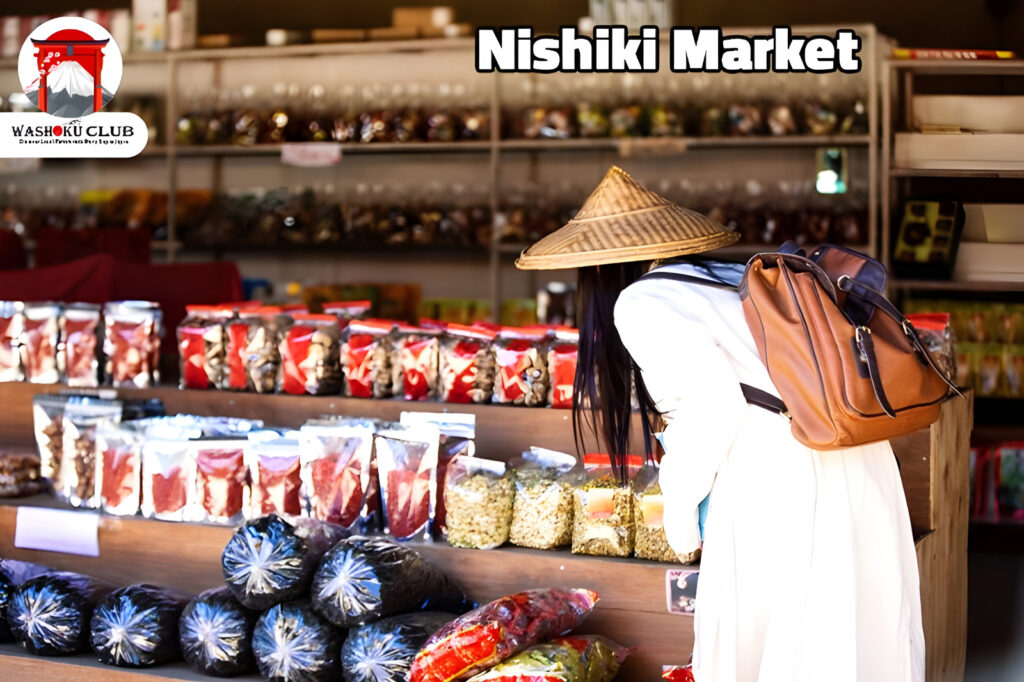
Nishiki Market, lovingly called “Kyoto’s Kitchen,” is a bustling, narrow street packed with more than 100 shops and stalls that have been delighting locals for centuries. Walking through Nishiki is a sensory adventure—you’ll smell the aroma of freshly grilled seafood, hear the sizzling of tempura, and see colorful displays of pickles, sweets, and spices at every turn.
Here you can find Kyoto’s most renowned flavors: fresh sashimi, yuba (tofu skin), delicate wagashi sweets, matcha everything, and even more exotic options such as octopus skewers stuffed with quail eggs! It is the perfect place to become connected to Kyoto’s rich food culture and speak to local traders who will never mind telling you about their past and tricks. Exploring Nishiki as part of a Kyoto Food Tour lets you dive deeper into the market’s history, uncover hidden gems, and savor authentic bites that reflect the heart of the city.
To make the most of this incredible destination, join one of our not-to-be-missed food tours at Washoku Club Culture and Food Tours Let our expert local guides lead you off the tourist trail behind Nishiki Market, show you secret spots you’d never discover by yourself, and take you to the best bites, from century-old restaurants to up-and-coming food stalls. Get ready for a flavour-filled adventure full of tales and memories you’ll remember for the rest of your life!
Arashiyama Bamboo Grove: A Walk Through Kyoto’s Green Dream
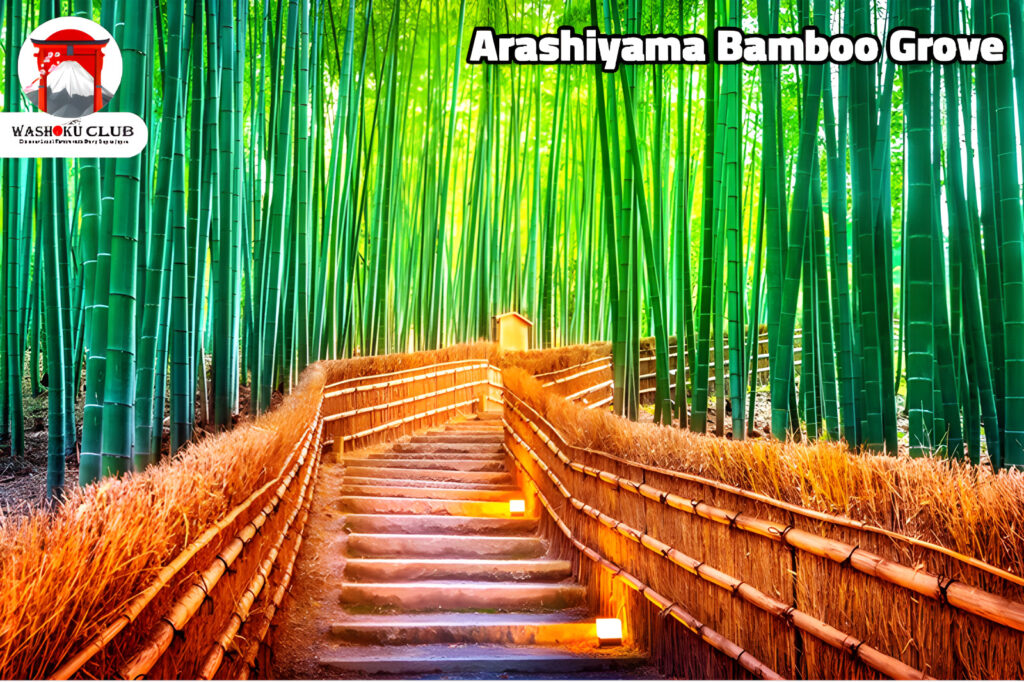
Arashiyama Bamboo Grove is pure magic. As you step into this towering forest of emerald-green bamboo, the world around you falls silent—the only sounds are the soft rustle of leaves and the soft crunch of gravel underfoot. The sunlight filters through the tall stalks, casting shifting patterns on the path, and for a moment, you feel completely transported into a dream world.
In western Kyoto, Arashiyama is more than the bamboo. The city also holds the peaceful Tenryu-ji Temple, the scenic Togetsukyo Bridge, and scenic streets lined with traditional boutiques and teahouses. To enrich the experience, many travelers combine their visit with a Kyoto Food Tour that lets them taste local sweets, street foods, and seasonal specialties around the area. Whether an early morning to outrun the tourist crowds or later in the golden hour when the light softens and becomes magical, Arashiyama offers a peaceful escape from the city’s chaos.
And here’s where your experience really gets even better—with our Kyoto Food Tours, you can combine Arashiyama’s natural beauty with a delicious sampling of local tastes. Picture hand-crafted soba noodles, fresh tofu, and seasonal sweets enjoyed while looking out over the mountains. We know exactly where to take you for the real taste of Kyoto countryside charm.
Philosopher’s Path: A Tranquil Stroll Through Kyoto’s Heart
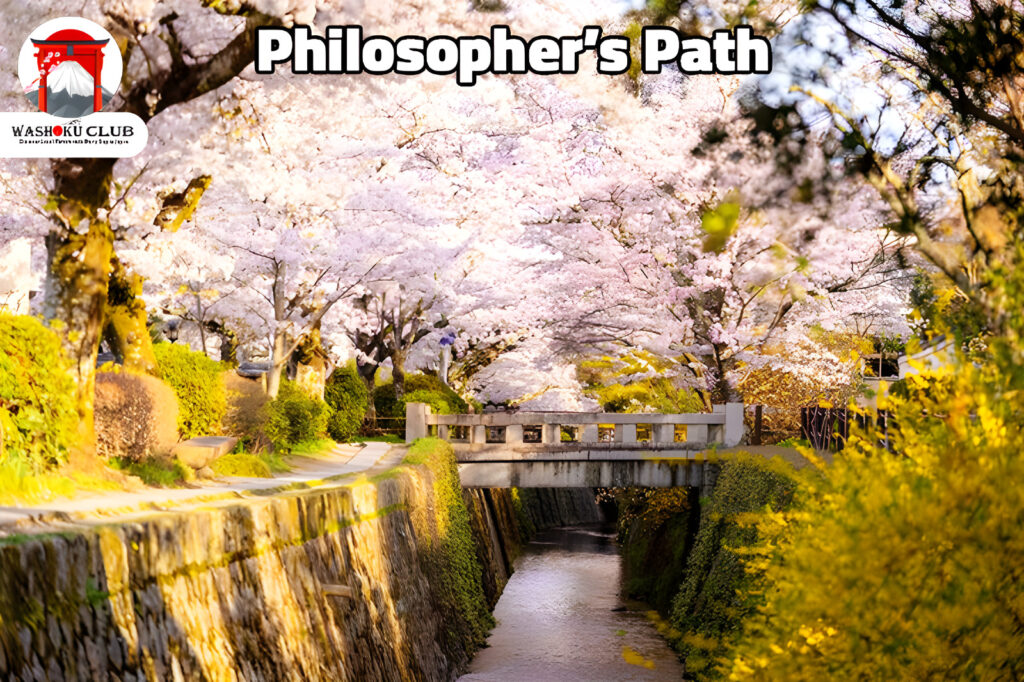
The Philosopher’s Path is the most tranquil and picturesque pedestrian route in Kyoto, a two-kilometer curving avenue beside a serene canal lined with blossoming cherry trees. So-called because the preeminent Japanese philosopher Nishida Kitaro purportedly spent each day’s meditation there, the path invites its travelers to stand still and consider as they make their way along the soft beauty of Kyoto’s Higashiyama ward.
During spring, the trail is a pink wonderland of cherry blossoms, arched gently over the water. In fall, autumnal maple leaves glow in bursts of red and gold, blanketing the earth. Along the path, there are hidden temples, small shrines, quaint cafes, and craft boutiques—all of which can be beautifully explored as part of a Kyoto Food Tour that combines cultural discoveries with local treats. This experience contributes to the serene and memorable character of the adventure.
Whether you walk it at sunrise or sunset, the Philosopher’s Path offers a moment of peace and harmony with nature and heritage. And after your walk, why not treat yourself to a delicious Kyoto Food Tour with Washoku Club Culture and Food Tours? Our guides can help you sample the best local food around, making your day a perfect combination of beauty and flavor.
Kyoto is a city that speaks to the senses, where every bite, every street, and every hidden corner whispers a story of centuries of tradition and modern innovation. From the serene grandeur of Philosopher’s Path to the packed stalls of Nishiki Market, from the quiet bamboo of Arashiyama to Fushimi Inari Taisha’s sacred gates, Kyoto is waiting to be discovered, savored, and loved.
With our specially curated Kyoto Food Tours at Washoku Club Culture and Food Tours, you are not just eating food, you are also learning about the heart and soul of this mystical city. From hidden market gems to local street food, our experienced guides are ready to give you a tour that you will never forget.
Ready to experience Kyoto like a local? Book your unforgettable food experience today with Washoku Club Culture and Food Tours, and let the flavor of Japan linger long after you depart.
